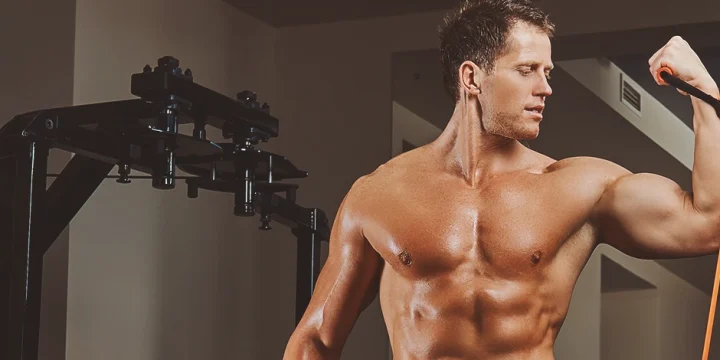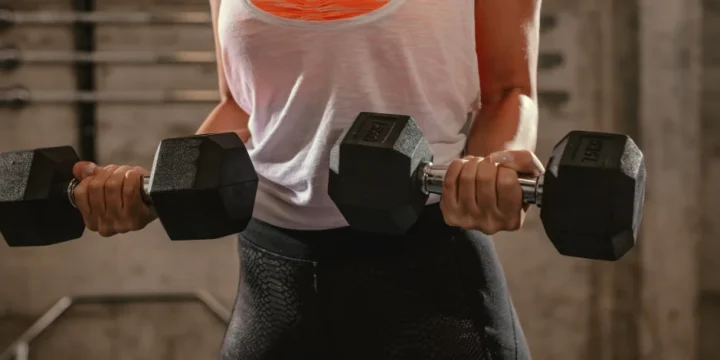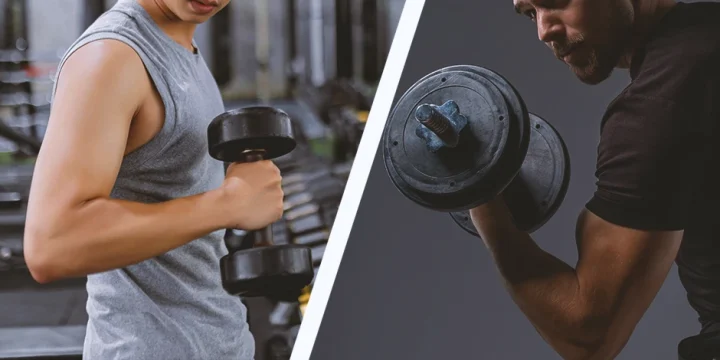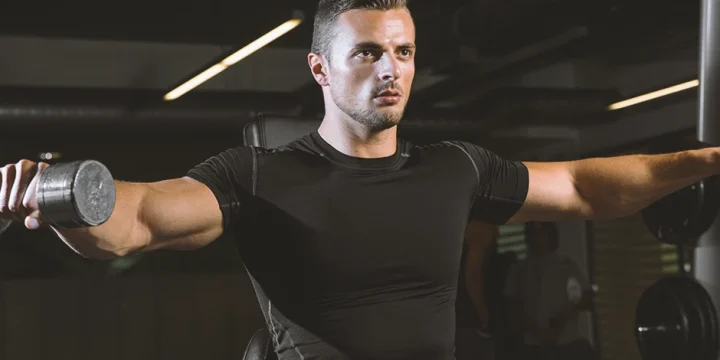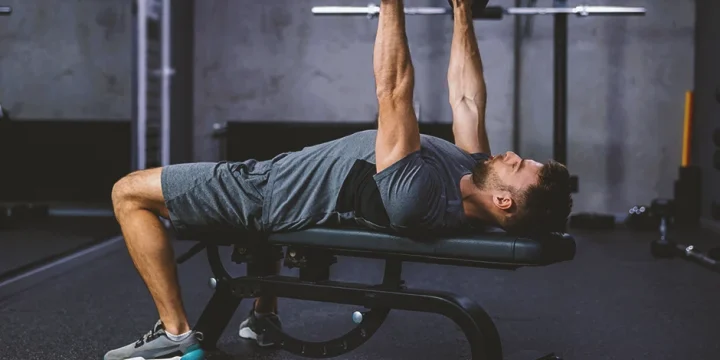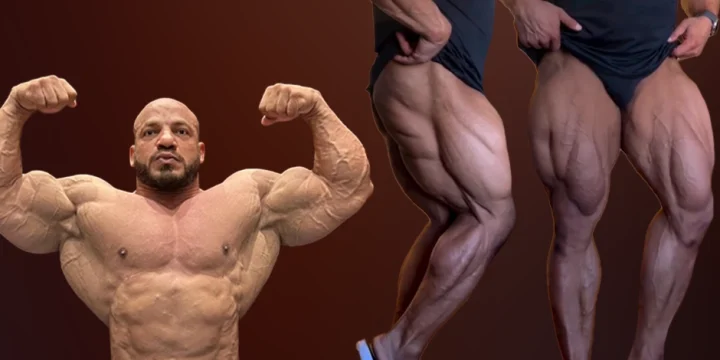Training for a biceps peak that speaks involves more than just a few curls.
To isolate the biceps that contribute to creating the peaks on your arms, you must exercise them with intensity and a wide variety of exercises.
But which exercises are best for biceps peak?
As a fitness trainer, I went through a vast amount of research to know the anatomy of the bicep and worked with my colleagues to develop the best exercises to train the biceps peak.
In this article, I will provide my research and expertise on the best exercises to perform.
Quick Summary
- To develop a more prominent biceps peak, prioritize isolated exercises, including preacher curls, incline curls, and spider curls, and train with a repetition and set range that promotes hypertrophy.
- The biceps have short and long heads, exercised separately with different workouts.
- According to research from PubMed, the rest period between sets is a critical component influencing acute and chronic responses to resistance training programs, which applies to the bicep muscles.
- Exercising both the short and long head of the biceps is essential for general growth, but if you want to target the biceps peak mainly, you must exercise the long head of the biceps.
Bicep Peak Exercises

Based on years of information I've collected from various personalized arm workout programs, I've put together a list of nine highly effective bicep exercises.
1. Incline Dumbbell Curl
The incline dumbbell curl is identical to the incline hammer curls, except that the palms do not need to face the body.
This is a conventional dumbbell curl, but the incline bench dumbbell curl loads up the long head more because the elbow is set further back.
How to perform:
- Grab a set of dumbbells and lie down with the back against a 45-degree incline bench.
- Bending your elbows, curl the dumbbells close to your shoulders without moving your upper arm.
- Pause for a few seconds, then slowly drop the load back to its starting position.
- Straighten your arms completely each time you resume the beginning stance.
- Repeat for reps.
2. Drag Curl
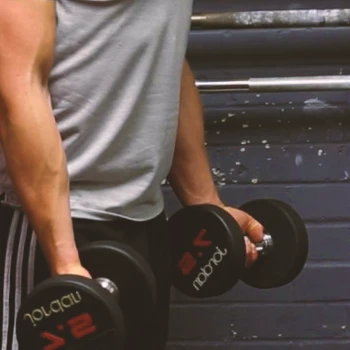
The drag curl is a variation that modifies the range of motion you'll exercise to increase the stretch to your biceps, resulting in more muscular growth.
How to perform:
- Set yourself up with two dumbbells as though completing a standard curl. Use a lofty kneeling stance on the floor to strengthen your form even more.
- Curl your arms up at the same time. Raise your elbows behind your body aggressively as you lift.
- Maintain your hands close to your torso, as if you were hauling the weight up.
- At the apex of the lift, squeeze your biceps.
- Drop the weight back down, maintaining your elbows behind your torso.
- Repeat for reps.
3. Dumbbell Hammer Curl
The dumbbell hammer curl focuses the long head of the biceps because the lifter uses a neutral grip (palms facing the torso).
This positioning and holding the elbows back when performing a hammer curl can aid in developing larger peaks.
How to perform:
- Start by holding a pair of dumbbells and standing upright with them by your sides.
- You should use a neutral grip, with your hands towards your body.
- Bend the arms slightly to increase biceps tension.
- Gradually curl the dumbbells up constantly while keeping your torso stable and your elbows at your sides.
- At the apex of the action, squeeze the biceps and then slowly drop the weight to return to the starting position.
- Repeat for the desired number of reps.
Also Read: Best Biceps Exercises With a Dumbbell
4. EZ Bar Curl
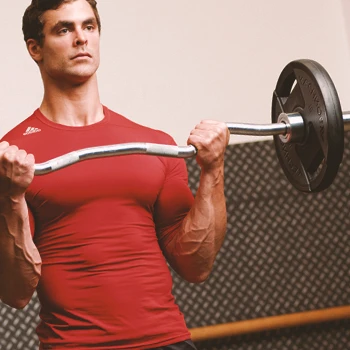
The EZ bar curl is a very popular biceps workout and a favorite among my clients. It is usually done for moderate to high repetitions as part of an arm or upper body exercise.
This movement can also be performed using an E-Z connection attached to a low pulley. This version produces an excellent contraction at the peak of the action.
How to perform:
- With an underhand grip, grab an EZ bar about shoulder width apart (palms facing up).
- Stand tall, feet together (you may find it more comfortable to put one leg back for support), back straight, and arms fully stretched. The bar should not come into contact with your body.
- Slowly curl the EZ bar up while keeping your gaze ahead, the elbows tucked down at your sides, and your body still.
- Squeeze your biceps firmly at the top of the action, then gradually drop them down to the beginning position.
- Repeat for the desired number of repetitions.
5. Preacher Curl
The preacher curl is a variant of the biceps curl that I've found to be highly effective in isolating the biceps.
It is a bicep peak workout in which you perfect your lifting technique with a regulated movement aided by a preacher bench.
Preacher bicep curls are performed by sitting on a bench with the armpits over the armpad.
How to perform:
- Sit on the preacher bench and set the seat height so your chest and upper arms are in contact with the pad.
- Lean forward and take an underhand hold on the EZ bar before you.
- Tuck the chin in and keep your arms stretched with a neutral wrist.
- Squeeze your biceps, bend your elbows, then curl until the EZ bar is at shoulder width.
- Keep your upper arms in touch with the pad throughout the workout.
- Gradually lower your arms to the starting position, reset, and repeat.
6. Concentration Curl
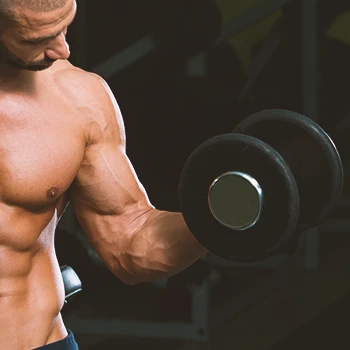
The concentration curl isolates your biceps more efficiently than other bicep peak workout variations.
Your posture causes you to move just at the elbow joint, enabling you to focus muscular contraction without the assistance of your shoulders or momentum.
Because you can truly focus on that contraction, the workout also targets the biceps peak.
I find the position of this exercise is excellent for assisting frazzled lifters in slowing down and emphasizing the form and technique of a curl.
"The main goal should be to generate that muscular contraction, but the position on the bench should be perfect to reap the benefits."
- Ebenezer Samuel, Certified Strength & Conditioning Specialist
How to perform:
- Sit on a flat bench with your back straight and a dumbbell in your hand.
- Place your feet level on the ground and slightly spread your knees to make a "V" with your legs.
- Hinge forward and place your elbow on the inside of your thigh.
- To balance your body, place the free hand on the opposite knee.
- Curl the dumbbell up to shoulder height.
- At the peak, pause and tighten your biceps.
- Resume the starting position.
- Repeat for reps.
7. Chin-ups
The chin-up is a pull-up variant designed to strengthen the back muscles, notably the lats.
The chin-up varies from pull-ups because it allows for more bicep engagement during the pulling motion.
Vertical pull exercises, like the chin-up, are essential for developing a well-balanced and influential body.
How to perform:
- Grab the bar with a supinated and shoulder-width hold.
- Breathe deeply, clench your glutes, and brace your core.
- By engaging the lats, depress the shoulder blades and push the elbows to the floor.
- Lift your chin towards the bar until your lats are fully tensed, then slowly bring yourself back to the starting position.
- Repeat for the desired number of reps.
8. Spider Curls
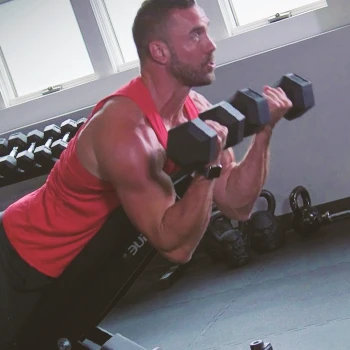
The spider curl is an arm muscle isolation workout that targets your biceps.
Spider curls are performed by resting your body on a 45-degree incline bench, or a spider curl bench explicitly made for this sort of biceps workout.
Spider curls, like concentration curls, demand a slow, controlled motion from start to finish.
How to perform:
- Set a flat bench at a 45-degree angle.
- Put your chin on the bench and your legs on the floor. Your feet should be long and straight, with a slight knee bend. Your weight must be distributed evenly across your feet.
- With your palms facing outward, grasp the dumbbells.
- Turn the shoulders outward to activate your lats, and hang your arms with a slight bend in your elbows.
- Throughout the action, keep your chin tucked. Activate your core. All reps should start from here.
- Squeeze your biceps and bend the elbows until the lower arms touch your upper arms while maintaining the upper arms still. The dumbbells should come near the shoulders without touching them.
- Squeeze your biceps and come to a halt at the peak of the exercise.
- Return to the beginning posture by slowly straightening your elbows.
- Repeat for the desired number of reps.
Also Read: How to Do Spider Curls Effectively
9. Cable Curl
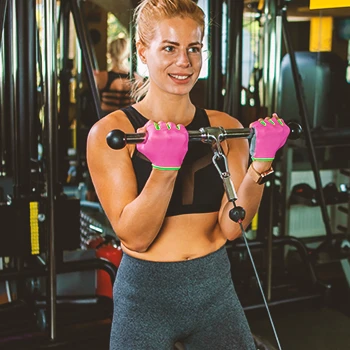
The cable curl is among the most effective workouts for activating the biceps.
This move will require the use of a cable machine.
How to perform:
- Connect a straight bar to the pulley and place it on the bottom rung nearest the ground.
- Take an underhand grip on the bar and stretch your arms, stepping back from the pulley. Maintain a shoulder-width distance between your feet and the bar between your thighs.
- Engage your core and use your biceps muscles to lift the bar toward your shoulders, bending the arms at the elbow as you go. Throughout the action, keep the elbows tucked into the sides.
- Stop at the top, then slowly and deliberately return the bar to the starting position.
- Repeat for the desired number of reps.
Anatomy of the Bicep Muscles

Your arms comprise three muscles: the biceps brachioradialis, brachii, and brachialis.
1. Brachioradialis
It is a lengthy forearm muscle that begins on the humerus and ends at the radial bone [1].
An overhand grip is ideal for training the brachioradialis.
2. Brachialis
The brachialis muscle extends from the midline of your humerus to the ulna [2].
Exercising the brachialis is vital for developing the biceps peak because it may elongate your biceps by pushing the brachii up from underneath.
The brachialis is best developed using neutral-grip movements like the dumbbell hammer curl.
3. Biceps Brachii
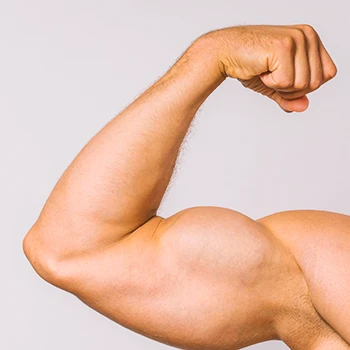
Biceps brachii has a short and long head. The short head starts at the front of the scapula and inserts at the top of your radius (the bone that extends near your thumb).
The long head also begins at the front of the scapula but follows a longer path to insert into the radius [3].
Concentrate on the long head to grow bigger arms and increase your biceps peak.
The long head is the most visible muscle in a back double biceps stance or while gazing at the biceps from the side.
4. The Biceps Long Head
The long head is a vital muscle head for both strength and appearance. It is the muscle located on the outside of your upper arm.
A well-developed, long-head bicep will always set you apart. Exercising the long head is vital while striving to increase biceps strength.
The long head may be felt and seen on the top and outside the region of the bicep. It gives your biceps the image of length and a prominent peak when you flex your arm.
How To Build a Bicep Peak

Below are some tips to help you in developing a prominent bicep peak:
- Prioritize workouts that emphasize the long head: Exercising both the short head and long head is essential for general growth, but if you want to target the biceps peak mainly, you must exercise the long head of the biceps. You should perform exercises such as the dumbbell hammer curl with a narrower grip to address the long head.
- Workout your biceps before your back if you do both on the same day: If you exercise your biceps and back on the same day, you should workout the biceps first so you may train them from a fresh, powerful starting point.
- Workout your biceps at least two times a week: Exercising the biceps at least two times a week permits you to increase the muscle's training volume and stimulation. Train the arms intensively and allow 48 to 72 hours between arm sessions. If you had the ability and wanted to accelerate muscle growth, you could even exercise the arms thrice per week.
- Exercise in the full-motion range: Every rep lets you activate the entire muscle by exercising in the full-motion range. Reducing repetitions should leave benefits on the board, so lower your weight gently and reach the full muscle stretch. When you've failed at these full-range sets, you may perform a few partial-range reps to add some volume.
- Exercise your biceps with both heavy and light weights: The biceps should be exercised in several rep ranges and intensities. Exercising with heavier weights for 5 to 10 reps can accelerate muscular development. Chin-ups and close-grip barbell curls are excellent exercises for this. You should also incorporate some lighter-weight training days, where you exercise the biceps in the 10 to 15 or even 20 to 30 rep range, employing a weight that causes failure within those rep ranges.
Mistakes To Avoid When Training Your Bicep Peak

I've seen many people cram their arm workouts in without giving their workout principles a second thought.
Over the years, I've noticed the following prevalent mistakes, which you should avoid while exercising the long head for a more significant biceps peak:
- Do not perform half-reps: Half reps won't help you concentrate the long head as you could. To achieve the most stretch on the muscle, do the curl in its complete range of motion when exercising the long head.
- Avoid extending the elbows too far forward: Raising your elbows is a fantastic way to grow muscle mass and better focus the short biceps head. If you are after the long head and want to build an enormous biceps peak, keep the elbows back (near your torso) when doing curls.
- Avoid using a wide grip: Curls with a broad hold are ideal for building the short biceps head, but you'll want to employ a narrower grip if you target the long head.
Trainer Tips for Bicep Peak Workouts

I've found four significant elements to consider when performing the long-head bicep routine:
- Volume
- Rep Ranges & Load
- Tempo
- Rest periods
1. Rep Ranges and Load
Understanding the ratio of slow and first-twitch muscle fibers in any muscle is critical. This will assist you in determining the optimal rep ranges and weights to work with.
The long-head bicep comprises 40% slow and 60% first-twitch muscle fibers.
Since fast twitch fibers are designed for short, rapid bursts of energy, they respond best to medium to high weights for lower reps.
Slow twitch fibers respond well to lesser weights for more repetitions. They are designed for strength and endurance.
As a result, it's critical to exercise the biceps with heavy weights.
Yet, this does not imply that you should exclusively use heavy weights for a few reps. The biceps are still made up of 40% slow twitch fibers.
For the best potential bicep growth, you should exercise across the complete rep range spectrum, which is as follows:
- 5-8 repetitions with a heavy load
- 8-15 reps with a moderate load
- 15-25+ with a light load
The load should push you to or close to failure within the provided rep ranges for it to be effective.
This will offer your biceps the best opportunity to grow and become stronger. They will also increase muscle endurance. This will result in gains in other parts of your exercises as well.
2. Volume
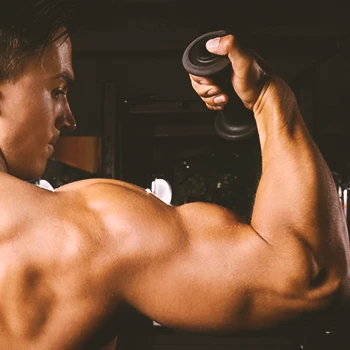
Years of working on my arms have taught me that you should aim for 10-15 sets of biceps every week. If you're more proficient and your biceps aren't responding, aim for 15-20 sets weekly.
The number of sets within the aforementioned rep ranges may be split down as follows:
- 50% low reps, high load
- 25% of moderate repetitions with a medium load
- 25% high repetitions with a small load
3. Tempo
Tempo is defined as the rate at which you complete a rep. It may be divided into two phases: concentric (curling) and eccentric (uncurling).
Rep pace is not something that many people consider when developing their biceps. It does, however, influence how quickly you grow muscle.
The common consensus on rep tempo is that varying lift speed increases your chances of muscular growth.
You should practice with moderate tempos most of the time and rapid tempos on occasion.
"Generally, the longer time under strain, the better for development; therefore, a slow pace is helpful for muscle growth. But it's also a good idea to experiment with tempo to jolt the muscle in various ways."
- Kirsten Yovino, Certified Personal Trainer
You should practice with moderate tempos most of the time and rapid tempos on occasion.
The finest tempos to employ are:
- Rapid concentric, stop at the peak, and squeeze.
- Slow concentric and slow eccentric.
The eccentric phase (negative) should always be performed slowly. In the concentric phase, though, you can experiment with explosive sets. Remember that your bicep is a rapid twitch muscle that reacts well to intense bursts.
4. Rest Period
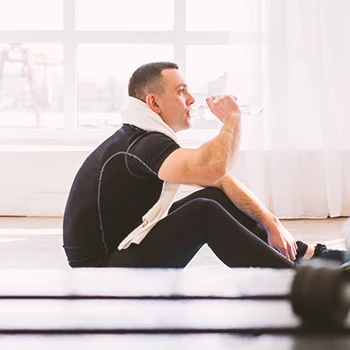
Over the years, I've learned that the rest duration is another component that influences muscle development.
According to research from PubMed, the rest period between sets is a critical component influencing acute and chronic responses to resistance training programs [4].
I'd like to categorize the rest break into three parts:
- Thirty seconds - short duration.
- 2 to 5 minutes - long duration.
- 60 seconds or more - moderate duration.
Long Rest Periods
An extended rest interval allows you to recover your breath and almost entirely regain your strength.
Maintaining stability at about the same level will enable you to lift a maximal weight, resulting in enormous muscular growth. Yet, there is a drawback to this.
The longer you rest your muscles, the more difficult it is to attain full exhaustion. Your muscles need fatigue (overload) to perform at their best.
Brief Rest Periods
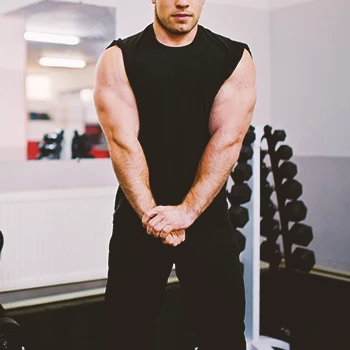
You will become fatigued when doing muscle-building exercises. At this moment, you tend to save energy by resting. You give your muscles a brief rest by taking this rest for 30 seconds or less.
Yet, you may not allow yourself sufficient time to recover if you do this. I've found this to be an efficient way of depleting the muscle.
Because both rest durations mentioned above are shortfalls, it is critical to experiment with rest periods. The activity will always determine your rest duration and whether or not you are employing heavy loads.
In general terms:
- Lighter loads need shorter rest.
- Moderate workloads require moderate rest.
- Heavy loads demand more extended rest.
"If you aim to be in good shape by increasing your physical fitness or endurance, keeping rest times to a minimum is the preferable option."
- Ryan Rogers, Certified Strength & Conditioning Specialist
For most people who want to maintain their fitness and drop a few pounds, it is best to minimize rest by simply moving during exercises.
Read more: Best Shoulder and Bicep Workout
Understanding the Genetic Blueprint: Bicep Shape and Peak Development
When it comes to sculpting impressive biceps, understanding the role of genetics can be as crucial as the workout itself. Genetics not only influence muscle size and strength but also determine the shape and peak of your biceps.
Here's a deep dive into how genetics play a pivotal role in your bicep development journey
1. Muscle Insertion Points: The Key to Bicep Peaks
The point where your biceps muscle attaches to the bone, known as the muscle insertion point, is genetically determined.
Some individuals have a higher insertion point, resulting in a more pronounced peak when the bicep is flexed.
Conversely, a lower insertion point might lead to a flatter bicep appearance but can offer an advantage in overall muscle development.
2. Muscle Belly Length: A Genetic Lottery
The length of your muscle belly is another genetic factor.
Those with longer muscle bellies might find it challenging to develop a prominent peak but can achieve impressive overall arm size.
In contrast, short muscle bellies often result in a more noticeable peak, giving the appearance of a more developed bicep even at lower muscle volumes.
3. Fiber Type Distribution: Fast-Twitch vs. Slow-Twitch
Genetics also dictate your muscle fiber type distribution.
Biceps with a higher proportion of fast-twitch fibers respond better to strength and power exercises, potentially enhancing the peak.
Slow-twitch fibers, while more endurance-oriented, can still contribute to bicep size and definition with the right training approach.
4. Setting Realistic Goals and Expectations
Understanding your genetic predisposition can help set realistic goals.
If you have a genetic makeup that favors a less pronounced bicep peak, focusing on increasing overall arm size and strength can still result in impressive arms.
Remember, every individual's body responds differently to training, and recognizing your unique genetic blueprint is key to developing a tailored workout plan.
5. Overcoming Genetic Limitations: Training and Nutrition
While genetics play a significant role, they aren't the sole determinants of your success.
Through targeted training focusing on both the bicep peak and overall arm development, along with a balanced diet rich in protein and essential nutrients, you can maximize your genetic potential. Consistency, dedication, and smart training can help you overcome genetic limitations to a considerable extent.
FAQs
What Exercise Hits the Peak of the Bicep?
The exercises that hit the peak of the bicep are the drag curls, hammer curls, incline dumbbell curls, narrow grip barbell curls, and incline hammer curls.
Why Do My Biceps Not Peak?
Your biceps may not peak because you are not getting enough sleep, are not eating correctly, and are destroying your body with stress or alcohol.
What Is the King of All Bicep Exercises?
Bicep curls are the king of all arm workouts since each rep works the whole biceps region.
References:
- https://www.ncbi.nlm.nih.gov/books/NBK526110/
- https://www.ncbi.nlm.nih.gov/books/NBK551630/
- https://www.ncbi.nlm.nih.gov/books/NBK519538/
- https://pubmed.ncbi.nlm.nih.gov/19691365/
About The Author
You May Also Like
